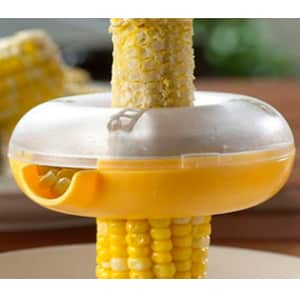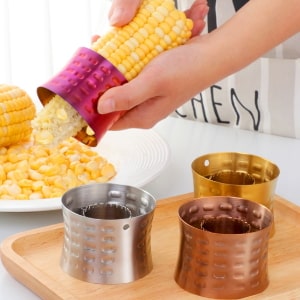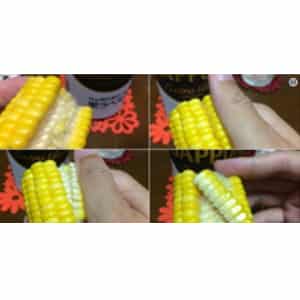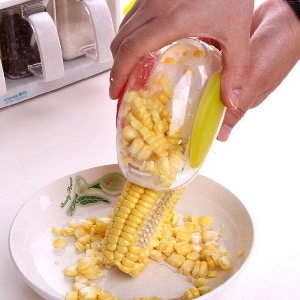How to peel corn from grains at home: the best life hacks for quickly processing the vegetable
Corn is liked by many: children and adults, adherents of a healthy lifestyle, lovers of high-calorie porridges and mixed side dishes, flakes and sticks, non-standard PP-baked goods made from a variety of flours. The healthy cereal is deservedly stored in the pantries and refrigerators of most housewives.
Corn is usually purchased canned or frozen, fearing the labor-intensive process of separating the kernels from the cob. Let's look at how easy it is to peel corn from the grains at home.
Cleaning corn in different types
The basic principle of cleaning corn does not depend on which cob is used: raw for long-term storage or pre-boiled for consumption in the near future.
In both cases, it is necessary to remove the grains that sit tightly on the cob.
Boiled

Boiled corn - a tasty, satisfying and healthy independent dish, which is distinguished by the softness of the grains and the relative ease of their separation.
However, it is in this softness that the main difficulty of cleaning lies: if the impact is too harsh, the grains simply break, and instead of a crumbly dish, the result is, although tasty, a mushy mass.
For quick and high-quality cleaning, boiled corn is recommended:
- first cut crosswise into several small pieces;
- Use the blunt side of a knife to separate one row of grains;
- separate the next rows by gently pressing on their bases with your fingers or the blunt side of a knife.
Raw
Raw corn much tougher than boiled. Its grains sit very tightly together, so separating them requires much more effort.
The principle of manual cleaning is in many ways similar to the previous one: just carefully remove one longitudinal row, and all the others will be removed much easier.
This is interesting:
How to Freeze Corn on the Cob at Home
Sweet corn: choosing the best variety and growing it correctly
Where and how to store boiled corn correctly: various methods
Methods for separating grains from the cob
The most common methods for quickly cleaning corn involve the use of additional manual or mechanical tools. Therefore, many of them are focused on working exclusively with raw, tougher corn.
Some methods are also applied to cooked cereals; the main thing is to reduce the force of mechanical impact.
Manual corn sheller
A popular and low-cost way to quickly clean cobs is to use a manual sheller. This device looks like a donut, along the hole of which there are small (up to 8 mm in height) sharp blades.
Step-by-step steps for cleaning corn using this sheller:

- First cut off the top and base of the cob by 1-2 cm, making it even and stable.
- Place the cob vertically and place the sheller on the top cut part.
- With both hands, lower the device evenly down to the very base, pressing firmly on it.
- Collect the grains, remove the stalk and clean the sheller for next use.
The operating principle of semi-automatic and automatic huskers is to use a special husking disk with small round teeth, which help separate the grains from the cob.
The disk rotates either by quickly turning a special handle (in semi-automatic machines) or using an electric motor.
Important! It is advisable to buy semi-automatic and automatic shellers if you need to process large volumes of corn - from several buckets.
Using a drill
This unusual method of cleaning cereal requires not only a drill and screws, but also strength, ingenuity and dexterity.
Clean corn with a drill like this:
- Select a piece of plastic pipe 30–40 cm long with a diameter 3–5 times greater than the diameter of standard cobs.
- At a distance of 5–7 cm from the top edge of the pipe, mark 7-8 equidistant points into which screws and drills are screwed. In this case, the length of each screw should be approximately 1/3 of the diagonal of the pipe, that is, the empty cob should easily, but not too freely, fit into the hole formed by the ends of the screws inside the pipe.
- The prepared pipe is placed with its lower end into a container for collecting grains (for example, a bucket or high basin), if possible, fixed vertically or carefully held during use.
- Select the longest self-tapping screw that will hold the cob. The cap is cut off and the end is inserted into the chuck of an electric drill or screwdriver.
- The next ear of corn is screwed onto a self-tapping screw inserted into the cartridge. Place it with its lower end on the screws screwed into the pipe, turn on the drill and lower the spinning cob down. The ends of the screws quickly and efficiently clean the grain.
Cleaning by hand
Manually removing the kernels is the most straightforward way to clean the cobs, requiring perseverance and strong hands. It is easier to shell raw corn in small rows running in a circle. The upper part of the cob, unsuitable for food, is first cut off with a sharp knife.
Each subsequent row is removed by pressing firmly on it with the lateral surfaces of the thumbs of both hands. If the grains are too tight and cannot be removed by hand, they are removed with a knife.
Some craftsmen advise cleaning well-dried cobs by rubbing them vigorously, which leads to the grains flying around each other.
With a knife
Another popular cleaning method that requires a little more skill and caution is using a knife.. It should be wide enough for easy grip by hand, durable and practically inflexible.
Most often, the seeds are simply cut off with a knife as close to the stalk as possible, which violates their integrity. However, this is quite acceptable if you plan to grind them into flour or use them for cooking porridge.
To obtain smooth and as undamaged grains as possible, it is necessary to remove the first longitudinal row with the blunt or sharp side of a knife (depending on the hardness of the seeds and the tightness of their adjacency to each other).
Each subsequent row is carefully squeezed into a suitable container, using the blunt side of the knife as a lever.
Lifehacks for quickly collecting grains
Preliminary cross-cutting of the cob will help speed up the cleaning of corn.
In this case:

- It is not the whole grain that is processed, but its small parts;
- the cuts made break the high density of adhesion of the grains to each other, which greatly simplifies their extraction;
- You can peel a short piece of stalk from both sides.
At the same time, there is a high probability of damage to the grains at the cut sites, so you will have to carefully separate them into those suitable for long-term storage and those that are best used in the near future.
To make cleaning raw corn take less time and not require much effort, it is recommended to first immerse the prepared cob in boiling water for 2-3 minutes. This will soften the grains and make them easier to remove.

You can put the cobs in boiling water and leave for 30–40 minutes or until the water cools slightly. In this case, even manual husking will be much faster and easier, and with a knife you will only need to lightly press the rows of grains.
Dipping corn in boiling water or soaking it is permissible only if the extracted grains will be used primarily for preservation or preparation. If you plan to store them in their usual form, it is better to use dry cleaning methods or thoroughly dry the extracted seeds.
Conclusion
Cleaning corn from kernels is not a difficult task if you prepare for it correctly. So, 1-2 cobs can be peeled by hand, with a knife or a simple peeler. For several dozen grains, it is better to use a drill or automatic hulling machine, and for serious preparations, prepare large containers of boiling water in advance and call household members for help.
Different cleaning methods allow you to get exactly the product you need: dry and whole - for long-term storage, slightly damaged and cut - for grinding into flour or making porridges and flakes, scalded and heated - for home canning.